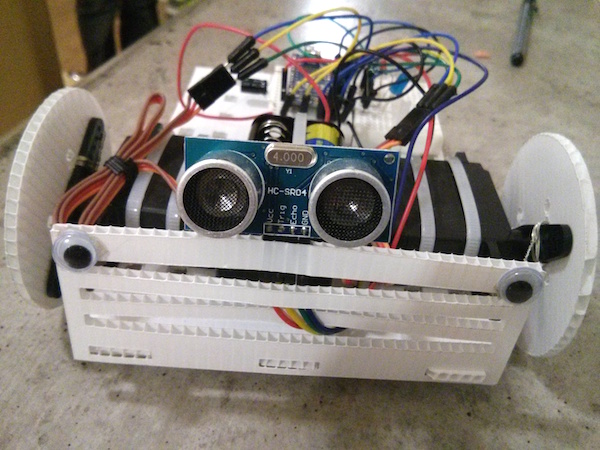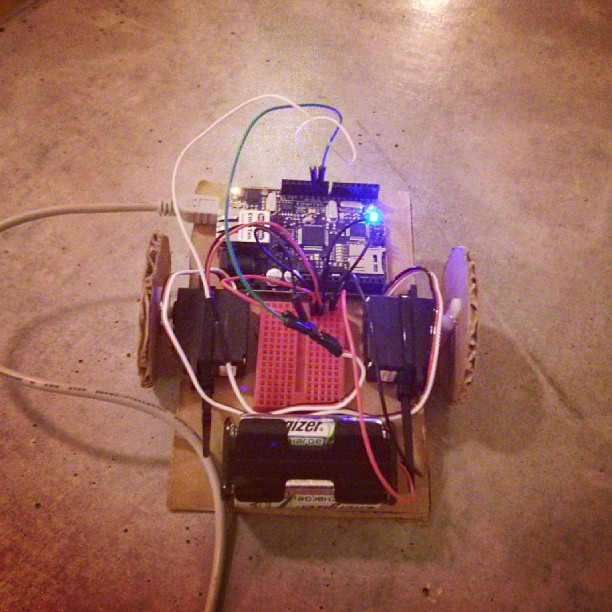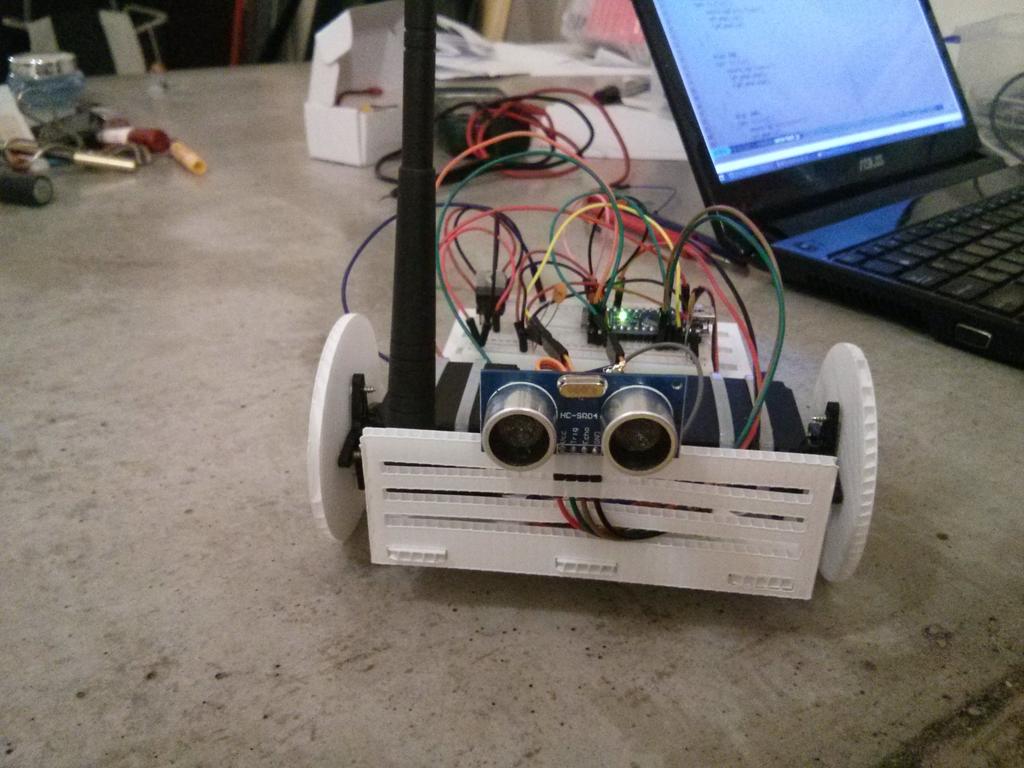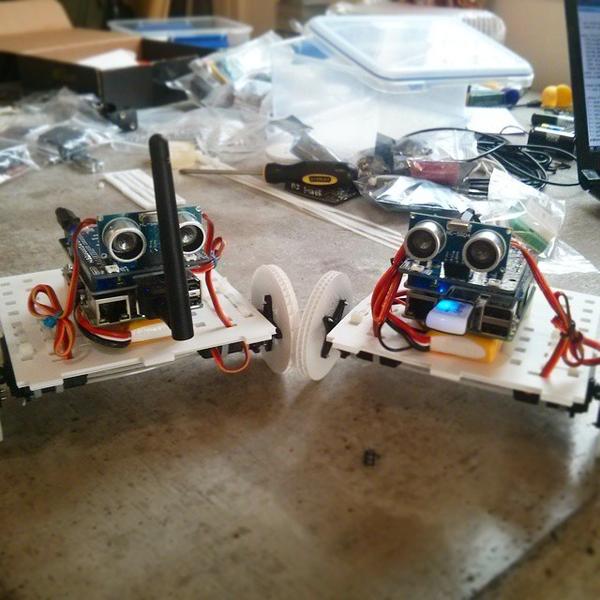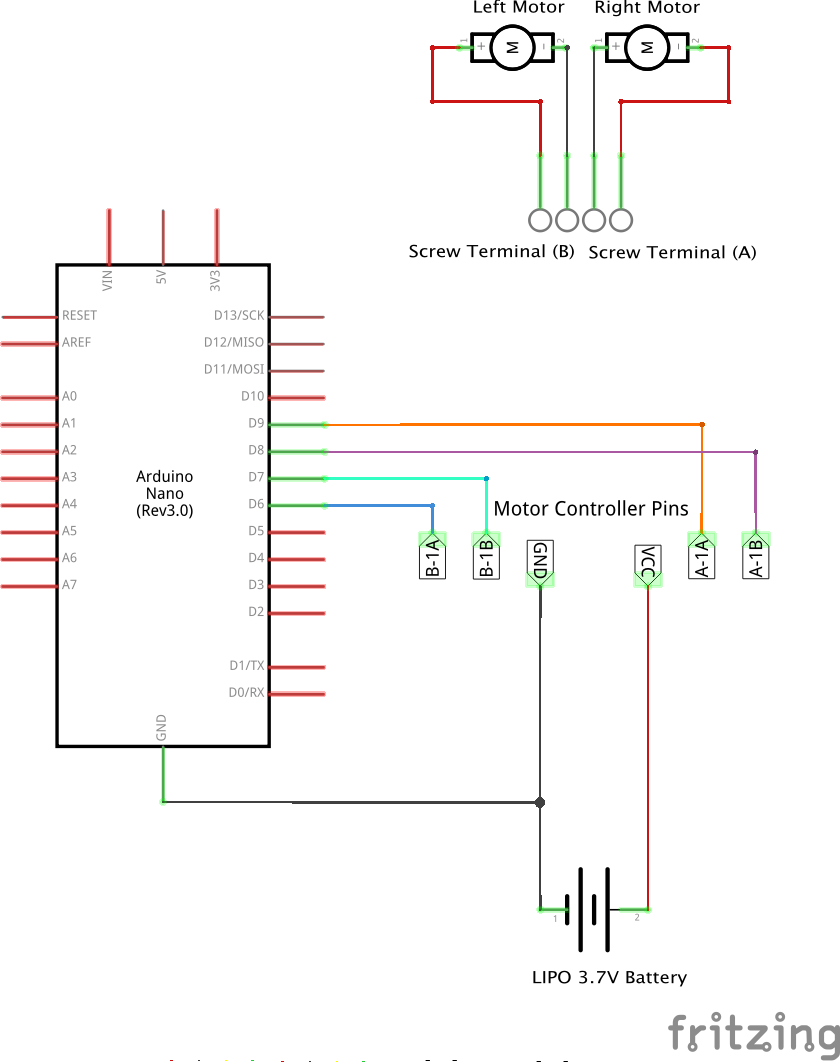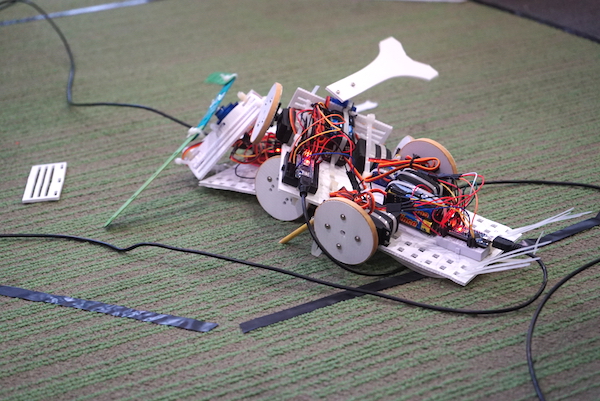SimpleBot
Overview
This is one of the most simple robots you can make. Features are:
- quick to put together (about an hour)
- very hackable (it can be built with cardboard, corflute or laser cut acrylic or wood so very easily modifiable)
- can move pretty fast (at full tilt it will go about half a metre a second - faster if you have more juice for the motors!)
- very extendable (much of the magic happens in code and sensors can be easily added)
- Cheap (costs less than AUD$100 which is very cheap for your first robot)
This bot is an adaptation of the excellent SumoBot Jr made by Paweł Szymczykowski but doesn't require laser cutting wood or plastic to make. However you can laser cut it if you want something a bit more long lasting.
Capabilities
The SimpleBot can be tethered over USB or controlled via Bluetooth Serial or over the network using WiFi. Your computer will do all the hard work of control processing and interface control etc and just send messages to the board to steer it.
If you get really sophisticated you can make it have some AI.
This is the very first prototype, put together in about 30 minutes one evening.
As this is such a simple robot, once you've got it working you can then extend it to make it much more capable including becoming wireless. This one has been extended with a wifi module to untether it from your computer..
Once you understand how things work you can reuse all of the components to make a bigger, badder, faster robot and switch the cardboard for more durable elements such as laser cut wood or plastic if you desire. We've even supplied the SVG and DXF files to do exactly that.
Add a raspberry pi and you get a SimplePiBot which can be made fully autonomous.
Materials needed
The following are the various components you need to get hold of to make a basic SimpleBot. If you're making this at a NodeBots event you'll have a set of components in your kits.
| # | Component | Notes |
|---|---|---|
| 1 | Arduino | We use Nanos because they are small and inexpensive (and light) but any arduino will do |
| 10 | M-M Jumper wires | The more the better but 10 will be enough to build with |
| 2 | DC Motors | These are common - get ones with wheels & gears |
| 1 | Battery pack | LiPo or 4xAA - about 5V is what you're after |
| 1 | Mini breadboard | Smaller is better |
| 10 | Cable ties | 3-4mm wide and about 100-200mm long is a good size to work with. The more the better |
Other things you might want to add to your bot:
- Laser pointer to make an annoying cat toy.
- Stickers to bling out your bot.
- Spikes to take out others; Ben Hur or Mad Max style.
- USB WebCam if you want to give your bot some vision.
- USB cable extender if you want some range.
- Bluetooth or wireless modules to remove the USB cable.
- An Ultrasonic sensor to do obstacle detection
- Reflectance sensors to do line following
Installation and setup
Start with the installation process outlined here if you haven't already done so.
Install the code dependencies
Clone the repo and install everything from here:
git clone https://github.com/nodebotsau/simplebot.git
cd simplebot
npm install
Flashing the arduino
Use interchange to install the firmware to the arduino. Plug the arduino in
and then run the following command from your terminal.
interchange install hc-sr04 -a nano --firmata
Assuming you get no errors, you're good to go on that front.
Run a basic blink program
Next, to test you've got Firmata running, run a basic blink program with the following command:
node examples/blink.js
If it all goes well. You'll see a blinking LED positioned next to the L on your arduino.
[ ] RX
[ ] TX
[*] POW
[*] L <--- this light will start flashing
Open the examples/blink.js program in an editor and look at the code. Its currently set to blink every 500ms.
Try changing this to 100ms and see if it blinks faster now.
board.on("ready", function() {
var led = new five.Led(13);
led.blink(500); // <--- try changing this value see if it blinks faster/slower
});Build a SimpleBot
You can go in a few different directions with the SimpleBot. Details for the different styles can be found below however the common principles are discussed in the next section.
Differential drive
Each SimpleBot is a little different because it's yours but the general principles are the same. You have two motors, each of which drive a wheel - this is called differential drive - and the combination of these working together will drive the robot forward, backwards and turn on the spot each way.
Use cable-ties (zip ties) to join everything to the chassis.
If you want to see a video explaining this in more detail there's a version on you tube (this uses servos on an older Mark III SimpleBot but the principle holds).
Basic wiring
The wiring diagrams are provided here:
Schematic:
Examples
A simple drive example
In the examples folder you can see an example called motors.js or
servos.js - choose the version depending on your motor types. This is
a very simple control example which uses the arrow and space keys on the keyboard
to drive the SimpleBot around.
Simply run:
node examples/motors.js SERIAL_DEVICEnode examples/servos.js SERIAL_DEVICEWhere SERIAL_DEVICE is the path to the serial port (eg /dev/tty/USB0).
You should now be able to drive your robot around happily. Go get a few friends to build one too and you can have SumoBot Battles.
Tuning servos
If you are using servos and they don't entirely stop then tune the stop value in the code by setting a LSTOP and RSTOP value that is a little either side of 90 (this is because CR servos are a hack and may need some tuning).
Driving over Bluetooth
You can use bluetooth to drive the simplebot.
Get a bluetooth module and configure it. This is a mandatory step before you can do it properly..
Wiring for BT.
Connect the BT Module TX pin to the Arduino RX pin and the BT Module RX pin to the Arduino TX pin and you should be ready to go. Note that if you need to flash the arduino or anything you need to unplug the BT module.
Connecting
Once you've got your bluetooth set up, pair it with your computer so it appears as a serial device.
Simply go:
node examples/motors.js /dev/tty.SERIALPORT
Changing the device path to whatever yours is to the Bluetooth Module. You should now be able to drive using wireless over bluetooth just the same as using a USB cable.
Game controller
If you happen to have a playstation controller then you can use the sb-controller.js example to drive your simplebot using a console controller which is pretty cool.
LICENSE NOTES
This SimpleBot repo is licensed using the MIT license for all components.
Firmata implementations are modifications of [https://github.com/firmata/arduino/](Firmata for Arduino) by [https://github.com/soundanalogous](Jeff Hoefs @soundanalagous) and others and is used according to the GPL.
Firmata modifications include merged components of the [https://github.com/jgautier/arduino-1/tree/pulseIn](pulseIn code) as created by [https://github.com/jgautier](Julian Gautier @jgautier).
